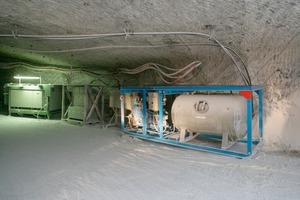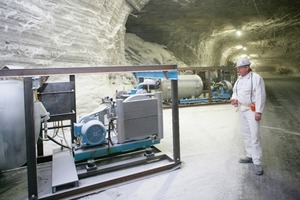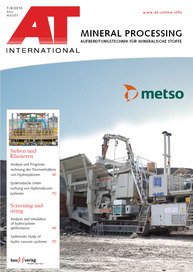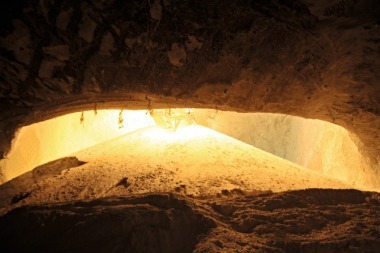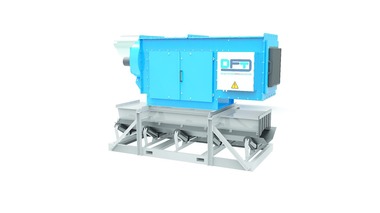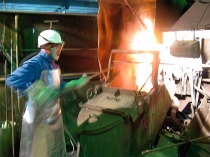Generation of compressed air under extreme conditions
For about 100 years K+S KALI GmbH have been extracting salt in the potash mine of Sigmundshall near Hanover. Up to 3 million t of crude salt per year are extracted there. This corresponds to an output of about 10 000 t/d. Mining starts at a depth of 350 m, the deepest floor level is 1400 m under the earth’s surface. The salt layer itself extends up to a depth of 3000 m. There is an underground roadway system of 300 km. So as to stope the deposit bit by bit, the room-and-pillar method is used, i.e. the salt deposit is vertically drilled and blasted progressing from bottom to top. Due to gravity the salt falls down to the lower main floor level. There it is taken by front-end loaders with a capacity of 12 t and 17 t and is transported to a crusher. The crushed crude salt is transported for miles by belt conveyors to the shaft bin, i. e. a surge bin near the main shaft. From there it is conveyed to the surface and further processed to become high-quality salts or fertilizers. The waste, i. e. crude salt that cannot be used for further processing, is returned to underground and is locally backfilled.
Comprehensive technical equipment is needed to mine and handle such quantities of crude salt. In Sigmundshall they have a fleet consisting of hundreds of vehicles maintained and repaired underground. Furthermore, compressed air is needed. A main consumer of this energy source is the expensive bag filter dust collection system at the transfer points of the haulage system. Without them it would not be possible to handle the crude salt at all.
Since the transfer points have to be shifted from time to time due to the rate of face advance, the compressors are designed as skid plants, i.e. they are moved on skids and transportable pallets (Fig. 1). K+S KALI GmbH, which decided to have BOGE as the main supplier for the equipment for compressed-air generation, use energy-efficient screw compressors of the series S with oil injection cooling or also durable lubricated reciprocating compressors. Depending on the compressed air requirement at the individual points, various sizes from S 31-2 with a drive of 22 kW up to S 100-2 with a motor capacity of 75 kW are used. A few minor dust collection systems, which have not been designed as semi-mobile units, get the required compressed air from rugged reciprocating compressors with a space-saving air vessel mounted below. Other BOGE compressors are mounted on drilling vehicles that are used to make holes and prepare blasting. These vehicles are equipped with one compact compressor of 7.5 kW each. Screw and reciprocating compressors from BOGE also supply the required auxiliary energy for stemming the holes.
All compressors are severely stressed underground though they are treated carefully and are maintained by experts (Fig. 2). Amongst other things, this is due to the higher ambient temperatures, which, in turn, are due to the fact that salt is an excellent heat conductor that transfers the heat from the earth’s interior, i.e. from a depth of 3000 m, to higher layers. Therefore, already at the 940 m level, the temperature is 35 °C and at a depth of 1400 m there are constant temperatures of up to 50 °C. The operating temperatures of the compressors are correspondingly high. Additionally, the compressors have to be operated continuously since the mine is run in three shifts. A further stress is the dust load with a high portion of fine dust, which makes high demands on the air filters. Moreover, the dust makes cooling more difficult. Without adequate measures the dust deposits on the equipment would soon reach a thickness of several centimetres.
The compressors from BOGE have proved a success at great depth for many years under these special conditions, i. e. extreme heat and high dust load.
BOGE KOMPRESSOREN Otto Boge GmbH & Co. KG, Bielefeld (D), Tel.: +49 5206 601-0, www.boge.de

